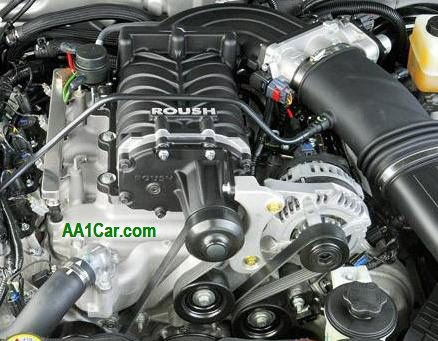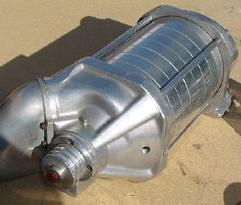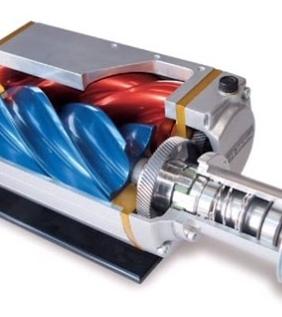Can I Put a Supercharger on Any Car

Home, Auto Repair Library, Auto Parts, Accessories, Tools, Manuals & Books, Car BLOG, Links, Index

Basics of Supercharging
by Larry Carley copyright 2019 AA1Car.comWhen it comes to squeezing more Horsepower out of a given number of cubic inches, nothing beats a supercharger (except maybe a turbocharger, which is the rival form of forced induction). The amount of power any engine produces depends on how much air/fuel mixture is pumped through it in a given instant of time. To increase the engine's power output, therefore, you either have to increase the engine's displacement (more cubic inches), increase rpm or increase breathing efficiency (called "volumetric" efficiency).
Engine speed naturally goes up when the throttle is punched opened, so for an engine of a given displacement the fastest route to more power is to increase its volumetric efficiency. A bigger carburetor, a better flowing intake manifold, a cam with more lift, duration and overlap, opening up the head ports, bigger valves and a free flowing exhaust are all traditional means by which an engine can ingest and pass more air and fuel. But even the best built naturally aspirated engine will never achieve 100 percent volumetric efficiency because atmospheric pressure can only do so much to overcome the restrictions and turbulence in the intake system. And as rpms go up, volumetric efficiency drops off.
The only way to overcome this limitation is to add a forced induction system. By mechanically increasing the volume of air that enters the engine, forced induction in effect increases atmospheric pressure giving the air more "push" as it enters the cylinders. Volumetric efficiency goes up and the engine makes substantially more power. Now the engine can breathe at 100 percent volumetric efficiency or higher depending on how much "boost" is built into the system. Crank up the boost pressure and even a little engine will come to life. That's the secret for squeezing hundreds of horsepower out of relatively small displacement four, six and even eight cylinder engines.

SUPERCHARGING OR TURBOCHARGING?
Forced induction can take one of two forms: supercharging or turbocharging. A supercharger uses a mechanically driven blower or compressor to push more air into the intake system while a turbocharger has a compressor wheel driven by hot exhaust gases exiting the engine.
Those who say turbocharging is the way to go cite the fact that a turbo doesn't create a parasitic horsepower drain on the engine as a supercharger does. Because is turbo is driven by "waste" heat in the exhaust, it delivers boost for free. But there's a penalty to be paid.
There is no such thing as free lunch. Though a turbo is exhaust driven, it still steals some horsepower from the engine by creating backpressure in the exhaust. The other drawback is that because a turbo is exhaust driven, there's an unavoidable time lag between the instant the throttle is opened and the time it takes the turbo to "spool" up and start delivering boost. The delay can stretch out to as much as several seconds depending on engine speed, load, what gear the transmission is in, the amount of plumbing in both the intake and exhaust system, the size of the turbo, the size of the intercooler (if one is used) and even the inertia of the turbo impeller and turbine wheels. A turbo has to wind up to tens of thousands of rpms before it develops boost, and that takes time.
Turbo lag can be reduced by carefully sizing the turbo, improved turbo design and mounting the turbo close to the engine. A smaller turbo spools up faster so smaller turbos are typically used for small displacement street engines to improve throttle response and low speed torque. But the tradeoff of using a smaller turbo is that it restricts power at the top end. Variable geometry turbos like the "dual scroll" housing that Mazda used their RX-7, or the Garrett turbocharger with moveable vanes can reduce turbo lag as can a lightweight, low inertia ceramic turbine wheel such as the one used by Buick in their 1987 Grand National.
Another tradeoff of using hot exhaust gases to drive a compressor wheel is heat. Turbos run hot, and part of that heat is transferred to the incoming air. Heat is also hard on the turbo bearings and oil supply, which can shorten the life of the turbo if the oil changes are neglected. Most turbocharged engines should use a high quality synthetic motor oil to protect the turbo bearings.
In recent years, car makers have often preferred turbocharging over supercharging for upping the performance of small displacement engines. They say turbos are more efficient, cost less or are easier to package under low profile hoods in cramped engine compartments. Yet there have also been quite a few late model performance vehicles equipped with supercharged engines such as the Ford Mustang GT500, Dodge Challenger Hellcat and Corvette ZR1.

Supercharged 6.2L Dodge Demon produces 840 horsepower with 14.5 PSI of boost pressure on race gas.
HISTORY OF SUPERCHARGING
Superchargers are as old as the internal combustion engine itself. In fact, Roots type blowers actually predate the internal combustion engine. While Otto was still trying to figure out how to extract power from burning gases with an internal combustion, reciprocating piston engine, Roots blowers were being used to ventilate coal mines and to separate wheat from chaff. There are countless examples of early automotive pioneers who used supercharging to set speed records and win races. But cost, noise and practicality always relegated superchargers to the race track or the exotic and the elite. Auburn, Cord, Duesenberg, Stutz, Mercedes-Benz and Packard were a few of the name plates to sport supercharged engines in the 1920s and '30s.
During World War I, the British turned to supercharging to shoot down German Zeppelins. To fly as high as the air ships, aircraft engines needed boosting to overcome the power loss that occurred at higher altitudes.
Supercharging received another boost when GM's Detroit Diesel Division developed the now famous 6-71 supercharger back in 1938. The Roots type blower was intended for use on heavy-duty diesel engines, but hot rodders soon realized the potential of the blower and began bolting them on flathead Fords. The rest, as they say, is history. The GMC 6-71 blower became synonymous with all out performance, and soon dominated both street and strip. Today numerous aftermarket suppliers offer their own versions of the GM 6-71, while others have developed blower designs of their own.
SUPERCHARGING ADVANTAGES
The primary advantages of supercharging over turbocharging are instant throttle response and more boost at low engine speed. Because a supercharger is belt driven off the crankshaft, it can deliver boost the instant the throttle is opened. Blower speed is directly proportional to engine speed, so if the blower is a positive displacement type (which most are), boost will increase at the same rate as engine speed. Thus there is no lag and the engine delivers right now power and tremendous low end torque.
A bolt-on supercharger can add anywhere from 30 to 50% more power to an otherwise stock engine. The hot setup is a small displacement blower (say 144 cu. in.) running at an overdrive of 1.75 to 2.25 that delivers 6 to 9 psi of boost pressure on a small block V8. This arrangement will deliver peak performance below 6000 rpm, which is where most street engines need the power.
Cost and reliability advantages are also claimed for supercharging over turbocharging. Unlike a turbo that spins at speeds up to 100,000 plus rpm, a blower operates at a much smaller multiple of crankshaft speed. The drive ratio between the blower and crankshaft pulleys determines blower speed (and thus boost), which generally does not exceed 12,000 to 15,000 rpm. Thus there is less wear and tear on the blower. There's also no hot exhaust gases to cope with so the blower bearings far cooler than their turbo counterparts.
Instant throttle response and low speed torque does have its price, however. Because a blower is belt driven, the amount of horsepower it takes to turn the blower depends on throttle opening and the blower drive ratio. The wider the throttle opening and the higher the drive ratio, the greater the amount of power required to drive the blower. A blower mounted on a top fuel dragster engine can siphon off as much as several hundred horsepower at top speed. But who cares if the engine is making thousands of horsepower? For street applications, the power drain is more modest. The horsepower power required to drive the blower on a typical OEM supercharger may be 50 to 60 hp at full throttle, but less than one horsepower at light throttle.
BLOWER SIZING & BOOST PRESSURE
For street applications, blower sizing is as important a consideration. A small blower works better at low speed and develops power more quickly than a large one. A large blower is great for top end power, but isn't as well suited to lower rpm operation because of its greater power burden on the engine.
One of the most important advantages of supercharging street engines is that it can transform a relatively stock motor into a real performer without a lot of expensive modifications. Supercharging can be a straight bolt-on installation, and it works well with stock heads, cams and pistons. What's more, it delivers better low speed throttle response and torque than a naturally aspirated engine with a big carburetor, big valves, high compression and "hot" cam.
Dyno tests have shown that a blower can be much more "streetable" than a naturally aspirated engine that's been built up to deliver an equivalent level of power. A blown engine is more streetable because it performs better at low rpms. A blower kit may cost several hundred dollars more to install than what it would take in equivalent engine modifications to obtain the same level of performance with a bigger carburetor or throttle body, hotter cam and modified heads. But the blown engine will deliver about 10% more power and torque in the lower speed ranges where it does the most good on the street. Besides that, a blown street motor looks great.
ENGINE MODIFICATIONS
Few if any engine modifications are needed if you are bolting on a supercharger kit for a stock street engine. Most street kits limit boost pressure to 6 to 9 PSI. But for higher boost pressures or racing, some engine upgrades are highly recommended.
To maximize the potential of supercharging, various changes will help the blower make the most power. Installing a "blower" cam will optimize the breathing characteristics of the blower and improve both low speed torque and high speed power. A long duration "performance" cam with a lot of overlap works fine in a naturally aspirated engine but is NOT a good choice for a supercharged engine because the boost pressure goes in the intake valve and right out the exhaust port at low speed. What works best with a supercharger is a cam with little overlap, a lot of lift, and increased duration on the exhaust valves (since the blower does nothing to help evacuate the cylinders). With a turbocharged engine, more lift and duration is needed on the intake valve to prevent backpressure (created by the turbo) from backing up into the cylinder.
One caution to keep in mind with any kind of forced induction system is compression. Because of the extra air and fuel that's rammed into the cylinders, detonation can become a problem if compression gets out of hand. Many blown race engines work best with a static compression ratio of less than 8:1 (7:1 or 7.5: 1 is best). The lower the static compression ratio, the higher the boost pressure you can safely run with the blower and the lower the rpm range at which the blower can develop peak torque. Street engines that run less boost pressure can typically get by with compression ratios up to 10 or 10.5 to 1.
If your supecharger will deliver more than 9 PSI of boost pressure, the following engine modifcations are usually necessary to reduce the risk of breaking something:
Replace stock cast pistons with flat top forged aluminum pistons
Replace stock cast iron piston rings with stronger ductile iron or steel piston rings.
Replace stock powder medal or cast iron connecting rods with stronger I-Beam or H-beam forged steel connecting rods or aluminum rods.
Replace a cast iron crankshaft with a forged steel or billet crankshaft
Replace the stock 2-bolt crank main caps with stronger billet 4-bolt main caps or a lower support girdle
If your engine has an aluminum block with unlined cylinders and you are running a high boost blower, have the block sleeved with ductile iron or steel cylinder sleeves.
Replace the stock head gasket(s) with solid copper head gaskets and O-ring the cylinder head(s) to handle higher cylinder pressures
Replace the stock cylinder head, connecting rod and main cap bolts with stronger aftermarket ARP head bolts.

Roush supercharged 5.0L Ford Mustang puts out 670 to 730 hp depending on boost pressure.
SUPERCHARGER TYPES
Superchargers are available in a variety of street and race only configurations. Roots type blowers are the most common and are called "positive displacement" pumps because they pump a given volume of air into the manifold. They come in various sizes with a pair of two or three lobe straight cut rotors, or a pair of twisted flute three lobe rotors. The longer the blower case and/or the larger the rotors, the greater the volume of air the blower can deliver to the motor.
A blower with two lobe rotors can pump more air than one with three lobe rotors, but it will also experience more "backflow" which reduces pumping efficiency compared to a three lobe design. Straight cut two and three lobe rotors can also be quite noisy, so that's why some blowers use the twisted flute three rotor design (typical of the OEM superchargers made by Eaton that Ford and GM have used over the years). A twisted flute rotor opens to the manifold cavity more gradually as it turns, which reduces backflow and the pressure waves that create noise.
Roots blowers are available from a number of aftermarket suppliers (see list of suppliers below).
 Paxton centrifugal supercharger
Paxton centrifugal supercharger Another type of forced induction system is the "centrifugal" supercharger which uses a rapidly spinning impeller wheel to pump air into the engine. It works like a turbo, but because it's belt driven it runs much cooler than a turbo and delivers instant throttle response. This type of blower can be installed on almost any engine, including many of today's fuel injected engines such as GM's Tuned Point Injection, Ford Mustangs and others. Paxton Superchargers, ProChargers and Vortech have vrious blower kits for many small block Chevys and Fords.
 Latham axial flow supercharger
Latham axial flow supercharger One unusual design is Latham's "Axial Flow" supercharger that resembles a fan compressor from a jet engine. A cylindrical rotor with dozens of little blades spins inside a bladed housing to compress the incoming air in stages. Like a centrifugal supercharger, it runs at high speed (470 percent overdrive) and is not a positive displacement pump but more of a high volume fan with an operating speed around 20,000 rpm! One of it's claimed advantages was a much lower outlet air temperature than a Roots type blower. The Latham supercharger was produced briefly from about 1955 to 1965, but never gained widespread acceptance.
Rotary piston and vane type superchargers have also been developed and used to pump air into engines. But this approach has yet to find much acceptance either at the OE level or on the race track.

Another innovate supercharger design is the Twin Screw supercharger (also called a "Lysholm" screw compressor or helix supercharger). The Twin Screw blower uses a pair of twisted rotors that pull air in one of the blower, compress it between the screw rollers, then pushes it out the back. The design is derived from a screw compressor originally designed for bus air conditioners. The Twin Screw design has a number of advantages over a roots blower, including better efficiency, it requires significantly less horsepower to drive the blower, and creates less heat in the compressed air.

Supercharger Suppliers:
Camden SuperchargersDyer's Blowers
Eaton Superchargers
Edelbrock Superchargers
ESS Tuning Superchargers
Hampton Superchargers
Littlefield Superchargers
Magnacharger Superchargers
Paxton Superchargers
ProCharger Superchargers
Vortech Superchargers
Weiand Superchargers (Holley)
Whipple Superchargers
 Related Articles:
Related Articles:
Horsepower & TorqueEngine Displacement
What is Engine Detonation
Turbocharger Diagnosis and Repairing
Related Resources:

TURBO GUIDE - Covers Turbo Operation, Diagnosis, Repair & Tuning
Be sure to visit our other websites:

Auto Repair Yourself
Carley Automotive Software
OBD2HELP
Random-Misfire
TROUBLE-CODES
Scan Tool Help
Can I Put a Supercharger on Any Car
Source: https://www.aa1car.com/library/supercharge.htm
 Related Articles:
Related Articles: